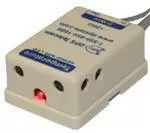Download our free Monitoring Fundamentals Tutorial.
An introduction to Monitoring Fundamentals strictly from the perspective of telecom network alarm management.
1-800-693-0351
Have a specific question? Ask our team of expert engineers and get a specific answer!
Sign up for the next DPS Factory Training!

Whether you're new to our equipment or you've used it for years, DPS factory training is the best way to get more from your monitoring.
Reserve Your Seat TodayD-Wire sensors provide an efficient way to monitor environmental conditions in your server room, PBX closet, or data center, with a broad temperature range of -40 to 180 F. By using the TempDefender's D-Wire technology, you eliminate concerns about analog capacity on your RTUs, avoid messy sensor wiring, and simplify installation by removing the need for analog connectors.

DPS D-Wire sensors use straightforward RJ-11 connectors for easy daisy-chaining, allowing you to link up to 16 sensors to a single TempDefender D-Wire port. With a maximum sensor chain length of 600 feet, you can extend monitoring to distant equipment without the need for multiple analog-capable RTUs. Keep in mind that internal D-Wire sensors - such as those for temperature or voltage monitoring - can affect the total allowable cable length.
The total length of a D-Wire daisy chain depends on the number of sensors connected. A single sensor can transmit data and receive power over a 600-foot cable, but as more sensors are added, power consumption increases, reducing the maximum possible cable length. For example, with three sensors, the total cable length would need to be 200 feet or less.
Below are some TempDefender sensor ordering options:

Temperature Sensor (D-PK-DSNSR-12001)
Temperature sensor that connects to the DPS Sensor network. This sensor can report live-analog values for monitoring temperature within +/-2 degrees F.

Temperature & Humidity Sensor (D-PK-DSNSR-12002.00002)
Monitor temperature and humidity using the D-Wire Temperature and Humidity combination sensor. This device can accurately report the live-analog values for temperature (+/- 2 degrees F) and humidity (+/0 4% RH).

Temperature Sensor w/ LED (D-PK-DSNSR-12003)
An additional LED on this D-Wire Temperature Sensor gives a visual notification on the sensor. Much like the standard Temperature Sensor, this device will monitor live-analog values and can report temperature within +/- 2 degrees F of the actual value.

Batt.Cell Voltage Sensor (D-PK-DSNSR-12004)
Battery Voltage Monitor & Temperature Probe that connects into the DPS Sensor network. This sensor is ideal for the digital inputs located on the Battery Voltage Monitor G2. Battery voltage range options include: 0VDC - 5VDC, 0VDC - 12VDC, 0VDC - 16VDC, and 0VDC - 60VDC.

Temperature External Sensor Probe (D-PK-DSNSR-12008)
External 8 foot temperature probe that is compatible with the DPS sensor network. This sensor may be plugged directly into a D-Wire point of a DPS RTU or may be the terminating point of a daisy chain of D-wire sensors. Note: This sensor probe is not daisy chainable.
Note: Distances will vary depending on D-Wire capable RTU. Consult applicable product section for product-specific D-Wire information. DPS recommends that no more than 16 sensors are used on a single chain, although up to 32 are supported on some platforms.
| D-Wire Temperature and Humidity Sensor Full Specifications | |
| Dimensions: | 2.25"H x 1.625"W x .9375"D |
| Weight: | 0.38 lb |
| Operating Temperature: | -40 to 180 degrees F (-40 to 82.2 degrees C) |
| Accuracy: | +/- 2 degrees F and +/- 4% RH |
| Aggregate Length: | 40 to 800 feet |
See Also: Data Center Management Techniques